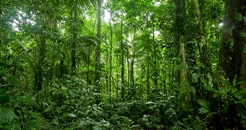 Camino Verde - a living seed bank
Camino Verde - a living seed bank
From an article by Reasons to be Cheerful
A living seed bank in Peru Is preserving the Amazon’s incredible plants. Within the sprawling, 130-hectare “living seed bank” at Camino Verde (Green Way), in the richly biodiverse region of Madre de Dios in Peru, there are over 400 species of native trees and plants with often incredible properties little-known to science.
Camino Verde sits alongside the Tambopata River, whose basin is one of the most ecologically rich areas on the planet. It is home to endemic species of birds, reptiles, mammals such as jaguars and pumas, and notably, at least 1,255 plant species.
In 2020, Peru recorded its highest levels of deforestation in history, with a total of 203,272 hectares of Amazonian forest lost — an area 2.5 times the size of New York City — due largely to logging and mining, according to Peru’s environment ministry. Since 2001, almost three million hectares have been deforested.
But Camino Verde is fighting to preserve these native plants before they’re lost forever — and it is helping them to blossom in the long-term through the support of (and benefit to) local communities.
The non-profit was set up by the American agro-forester Robin Van Loon, now the non-profit’s executive director, after he visited the area as a student. Camino Verde is based in the buffer zone of a nature reserve in Tambopata province, with a team of about 25 Peruvians leading the effort.
Robin Van Loon was fascinated by the cultural side of Amazonian agriculture and sought to learn more about the traditional methods. But when he asked around, even at local nurseries and government offices, about native species and seeds most people had no idea. So, as Van Loon puts it: “We rolled up our sleeves and got planting.”
The concept of Camino Verde is to cultivate native species in a “living seed bank” that safeguards their future as well as actively promoting their sustainable use throughout the region and other parts of Peru as a source of livelihoods for communities. One of its key arguments is that the Amazon rainforest can be restored within our lifetimes.
On the surface, it looks like a normal, albeit particularly mesmerizing, stretch of tropical jungle, save for the seedling nursery and grouping of wooden huts used for research and accommodation. Rather than being a traditional kind of dry storage facility, the seeds are collected directly from the forest floor during the relevant seasons.
The seed bank’s efforts have been focused on the most overexploited and endangered species, and to date more than 200,000 trees have been planted, with tens of thousands of tree seedlings produced at their tree nursery every year and donated or sold at-cost.
For example, Camino Verde provided 40,000 seedlings to the Amazonian Scientific Innovation Center (CINCIA), a non-profit that is restoring degraded former mining lands in Madre de Dios. It also donated 20,000 seedlings to the municipality of Puerto Maldonado, the departmental capital city, whose main square and other public spaces now contain an array of native plants.
Silvia Bacci, a seed biologist and project officer for Latin America at the Royal Botanic Gardens, Kew, in London, which is home to one of the world’s most important seed banks, says that the “living” aspect of Camino Verde’s project is particularly important given the climate and conditions of the region. “These places hold a lot of biodiversity. The percentage of plant species that have likely not been discovered is high.”
But crucially, Camino Verde believes that one of the most effective ways to preserve native seeds is to encourage the regular use of them among Amazonian communities. It provides seeds and seedlings to Indigenous and local farmers to promote a switch away from non-native cash crops like corn, rice and yuca, which in recent years have come to dominate agriculture to the detriment of biodiversity. Examples of new crops are native citrus fruits, Amazonian vanilla, wild cacao, honey made by stingless bees and plants which produce essential oils which can be harvested throughout the whole year.
And the fruits of that labour are impossible to miss: Camino Verde’s lands teem with marvellous creatures, including great lines of tropical centipedes that could reach 10 meters in length; hundreds of white and yellow butterflies sucking up minerals from the riverbanks; and howler monkeys letting out primal screams from the upper canopy.
Read the full article here.
Retweet about this article:
From an article by Reasons to be Cheerful, 24/09/2024